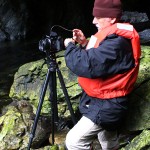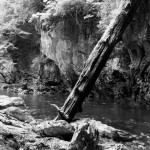I was pleasantly surprised to learn that one of my fellow voyagers our annual boat trip was an avid photographer. The wilds of Alaska are simply candy for a camera, spectacular photos can be seen in every direction waiting to be captured. As usual I was ready for photographic effort, with no less than four cameras along, not counting the cameras in my phone and iPad. The Canon 60D, EOS-M, a Canon G12 and a GoPro 2 HD comprised a nice array of capability. I was looking forward to the conversations and maybe a chance to learn a little from another photographer.
There was a surprise when I saw the photo gear Randy was unpacking, it looked a little odd.
Randy was shooting… Umm… How do I put this delicately… Randy was shooting film.
Yes, remember that stuff that came in rolls. For those who might not remember, this is how we took photos before digital sensors, megapixels and SD cards became the language of photography.

The setup is not compact, a bulky camera requiring a full backpack to carry with the camera, lenses and light meter. It is around fifteen pounds of gear, quite a contrast to the two or three pounds the EOS-M I used for most of my shooting.
The medium format camera presents difficulties on the boat. Taking long exposures is impossible from a moving and rolling platform. Still, he managed some nice shots when the water was calm, as it was when we visited walls of ice in Glacier Bay. Finding solid ground for the tripod required breaking out the launch and going ashore. We created a couple of great opportunities, landing on algae covered rock, we slip and slide to a place where the beauty of Marble Grotto is fully exposed. Another slippery landing, this time caused by glacial mud, allows us to explore the face of Reid Glacier with cameras and tripods at hand.
Worse, his medium format film only provides ten exposures per roll, much worse than the 24 or 36 shots I remember from my film days. With so few exposures available the photographer is strongly encouraged to make every shot count. As Randy dug another roll out of his kit I simply shot a few more frames. A 16Gb SD card is enough memory to shoot on for hours. While I need not worry about changing film, I do have to worry about batteries, there are two more charged packs in my pocket.
I have been considering black and white lately. Spurred by the desire to create decent photos out of some underwater shots that are otherwise ruined through poor color balance. To that end I have been exploring how to create black and white images from digital color images. Creating black and white from a digital image is possible, but not as effective as a truly black and white shot. There are few native black and white digital cameras, usually very expensive options. The most accessible way to shoot black and white remains film.

I encouraged Randy to consider carrying a small digital camera alongside his film gear. One of the mirrorless designs would be perfect, providing an alternative to use when the shot is not appropriate for the effort required of the film camera.
It appears my arguments were not in vain, when I arrived home I learn that Randy had purchased a digital camera before even leaving Juneau. His foray into digital is courtesy a Fuji XE-1, probably not a bad choice. This is the camera he took on a backpack trip into the Olympic Mountians a week later. His experience is not all good, he has quite a few comments about the camera, pointing out some of the shortcomings. Good or bad, I expect he will be carrying a digital camera at least part of the time.
Randy’s comments had their effect on me as well… As I perused Randy’s photos I was wondering… Maybe I should try this, it has been a while. I found myself out in the garage, digging out a really old camera bag from storage. In the bag are a number of old 35mm camera bodies. A Canon Elan IIe, a Canon A-1 and even a Canon F-1. The F-1 seems to have something wrong with the shutter, it does not quite close properly. The A-1, the first 35mm camera that I owned, blowing my basic training paycheck on, seems in good shape but is missing a battery to be certain.
There is also a 1970’s era Nikomat FT in the bag, a good match to some very nice Nikkor prime lenses I still use for astrophotography. I pull the camera out to check functionality, everything works, no surprise for an all manual camera. The light meter needs a battery, it is only $4.95 on EBay for a pack of five.
I wonder where I can get some film.


Been on film for a couple of months now.
Fuji 200 and 400 from Longs.
I did order me some TriX from the eVilness though it costs a bunch to process and print.
You can still get stuff like ektar and portra though it’s sort of pricey.
Check out Ilford too.
Moving on to Lomography and expired film.
As far as digital, if you’re on Lightroom, try the Nik’s Silverlight plug in.
I have a few rolls of Ilford FP4 on order from Amazon… Free shipping! There is a roll of rather old Ektachrome and a few rolls of Kodak print film in our refrigerator, been there for many years, may use it to test the camera.
The camera needs some repair. A few minutes ago I bit the bullet and took it apart, taking the top cover off. Not much problem using the instructions on some of the enthusiast websites. I confirmed one of the CdS photocells in the light meter is bad. The original parts are not available. Using the specifications in the 1970 Nikon repair manual I located some modern parts that should work, now on order from EBay.
Batteries from EBay are 1.5V, the old 1.3V mercury batteries are not available (big surprise). Will calibrate the circuit for the new voltage while I have it apart. A set of foam to replace the light seals is also on order. EBay may be evil, but where else are you going to get this stuff;)